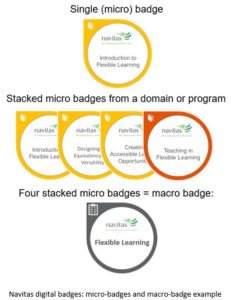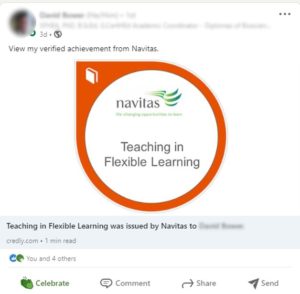Microcredentials and me: Unpacking the benefits of digital badges

Digital badges, short courses, and microcredentials – you have likely encountered these terms in the workplace, on social media, or in news reports, where they are often lauded for their potential to disrupt and revolutionise how we access, engage with, and validate learning.
But what are microcredentials, and how can they support you to upskill, develop new competencies, gain recognition of, and evidence your professional development and lifelong learning?
What are microcredentials?
Put simply, microcredentials are industry-certified qualifications that allow learners to evidence and verify training, skills, and competencies obtained through short-form, generally online educational courses, and programs. According to the Australian National Microcredentials Framework (Department of Education, Skills and Employment, 2021), microcredentials must be outcome-based, include assessment of the learner’s attainment of the intended learning outcomes, and be transparent and accessible.
Microcredentialled courses require a smaller time investment than we tend to see in formal higher education (with a minimum learning volume of one hour) and should not require a greater time commitment and/or volume of learning than an Australian Qualifications Framework (AQF) award (Department of Education, Skills and Employment, 2021). Microcredentials allow learners to upskill or reskill by studying a targeted topic or subject area without the commitments or costs of a formal degree.
What are the benefits of microcredentials?
Some of the benefits of microcredentials include:
- Providing employers and peers with visual, verifiable recognition and evidence of the knowledge, skills, and competencies the learner has developed
- Being accessible and flexible: breaking down barriers to learning, allowing self-paced learning anywhere, anytime
- They require a smaller time commitment than AQF awards, allowing busy learners to upskill and apply new knowledge quickly
- They allow learners to address current skill and knowledge needs in emerging areas (think back to the start of the pandemic, when many teachers enrolled into how to teach online MOOCs and short courses, in order to ensure they had the capabilities and skills required to support student learning after the rapid shift to online teaching)
- Can promote a culture of lifelong learning
What is a digital badge?
Upon completion of a microcredentialled course, the learner is awarded a digital badge which certifies their achievement. A digital badge is an image-based digital asset containing metadata describing the outcomes attained by the learner. Digital badges can be shared to social media platforms, such as LinkedIn or Twitter, or added to your email signature, website, or resume. This allows you to verify and showcase your skills, knowledge, and capabilities with a broader audience, including current and future employers.
Digital badges can also be “bundled” or “stacked” together to demonstrate mastery of a specific set of micro-credentials representing related skills or concepts (Utah Education Network, n.d.). For example, the Teaching Excellence at Navitas (TEN) Flexible Learning suite consists of four stackable modules designed to enable teachers to develop the knowledge, skills, and competencies required to design and deliver engaging, student-centred flexible learning. You can select to enrol in and complete just one of these Flexible Learning modules and receive a single badge, also known as a micro-badge, or, depending on your professional development needs and teaching context, you may choose to complete all four modules and receive a Flexible Learning macro-badge which verifies the acquisition of these four stackable badges. At Navitas we stack digital badges by grouping domains, capabilities, staff roles and college specific programs.

Is this new?
Yes and no. As many lifelong learners will be aware, online short courses and credentials have been available in some form since the early 1980s. Similarly, the idea of ‘unbundling’ higher education into smaller parcels, functions and courses has been mentioned in literature since at least 1975 (Brown and Mhichil, 2021).
However, Covid-19 and the shift towards online and hybrid learning and training has seen micro-credentials elevated due to their potential to rapidly upskill and reskill the workforce (Department of Education, Skills and Employment, 2021). As Brown and Mhichil note, “the global momentum for micro-credentials provides an opportunity to realign, reassess and even reimagine existing credential frameworks to help realise the goal of a more equitable, socially just, and thriving learning society – for all” (2021, p. 2).
How do I earn a Navitas digital badge?
There are a number of ways to earn a Navitas digital badge, for example, by successfully completing a professional development program, such as the Flexible Learning Design Program (FLDP), or by completing any Teaching Excellence at Navitas (TEN) module, including the compulsory final assessment. TEN modules are open to all Navitas academic staff globally. Assessment tasks, criteria and rubrics are available in each module. After successfully completing a module, you will be advised through an email notification of your achievement. You can then claim your digital badge and, if you choose, share it.
See below for an example of a Navitas digital badge shared via LinkedIn:

To begin earning a Navitas digital badge, explore the TEN catalogue, or keep an eye out for correspondence from Learning and Teaching Services to learn about future professional development opportunities.
For more information on microcredentials for staff and students, email Navitas Learning and Teaching Services: learningandteaching@navitas.com.
Additional resources:
- Teaching Excellence at Navitas (TEN) catalogue and enrolment portal
- How to share your Navitas digital badge
- Australian National Microcredentials Framework
- Accrediting teaching excellence: Digital Badges
References:
- Brown, M & Mhichil, M. (2021). Unboxing Micro-credentials: An Inside, Upside and Downside View. Culture of Education, 8(2). https://www.dcu.ie/sites/default/files/inline-files/unboxing-micro-credentials-2021.pdf
- Department of Education, Skills, and Employment. (2021). National Microcredentials Framework. https://www.dese.gov.au/higher-education-publications/resources/national-microcredentials-framework
- Utah Education Network. (n.d) Microcredentials: Frequently Asked Questions. Utah Education Network. https://www.uen.org/utahmicrocredentials/faq.shtml
Feature photo by Luis Cortés on Unsplash
